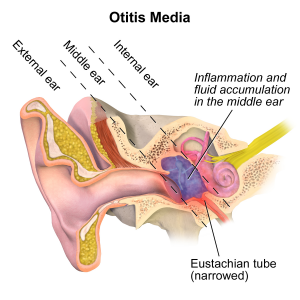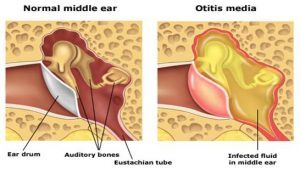Otitis Media
What is otitis media?
Otitis media is a broad term for any inflammation of the middle ear. It occurs commonly in young children below the age of 10 and is one of the major reasons for children visiting GPs. Adults may also be affected, however it’s far less common. The symptoms vary according to the severity and type of otitis media and may include hearing loss, earache (otalgia) and temperature or fever. The condition may last for a short period or may be chronic.
What causes otitis media?
A bacterial or viral infection is generally the cause of the middle ear inflammation and may result following an upper respiratory tract infection (e.g. common cold).

Below is a list of risk factors that increase the likelihood of contracting a middle ear infection.
- Children are more likely to contract middle ear infections
- Children attending day care
- Poor health conditions and sanitisation
- Smoking or passive smoking
- Family history
- Cleft palate
- Down’s Syndrome
- Turners Syndrome
- Craniofacial abnormalities
- Immunosuppression
- e.g. individuals undergoing transplants will be taking immunosuppressive drugs that decrease their bodies ability to fight infection
What are the different types of otitis media (OM)?
Acute OM, OM with effusion and chronic OM are the three main types.
| Type of Otitis Media | Description |
|---|---|
| Acute Otitis Media | ● Begins suddenly ● Earache, fever and irritability (in a child who can’t communicate that his ear is sore) ● Fluid build up in the middle ear (this fluid contains millions of bacteria or virus particles) ● Hearing loss ● Pus running from the ear may be present if the fluid build up results in the rupture of the ear drum |
| Otitis Media with effusion | ● May occur following the initial acute infection and the fluid continues to build up within the middle ear cavity ● No earache, fever or irritability ● Fluid within the middle ear, however contains no viruses or bacteria or very few of them ● Generally there will be a hearing loss |
| Chronic Otitis Media | ● Persistent or recurring middle ear infection ● This is more likely to occur if OM is not treated |
In order for us to hear, our ears need to convert sound waves into electrical impulses that travel in neurons to our brain. For this to occur sound waves strike the eardrum causing it to vibrate and this vibration in turn causes the tiny bones (ossicles) within our middle ears to vibrate. These movements end up stimulating nerve endings that send messages to our brain. However, if there’s an obstruction within the middle ear and for some reason the eardrum cannot vibrate properly or the bones in the middle ear cannot move properly this causes a hearing loss. The fluid build up within the middle ear due to otitis media prevents the eardrum and the ossicles from moving freely. It creates a blockage within the ear causing hearing loss.How does otitis media cause hearing loss?
If the eardrum bursts (tympanic membrane perforation) due to excessive build up of fluid this may also cause further hearing loss as it will prevent the eardrum from vibrating freely.
Will hearing loss due to otitis media resolve or is it permanent?
Generally the hearing loss will resolve once the individual no longer has otitis media. This may occur spontaneously or may occur following a course of treatment. However, in cases of chronic OM or if additional complications resulted there may be a more permanent hearing loss. Chronic OM may result in tympanosclerosis (scarring of the eardrum), cholesteatoma (abnormal skin growth behind the eardrum) and mastoiditis (inflammation of the mastoid bone). These complications can also cause hearing loss and may necessitate further surgery or the use of hearing aids.
Why is otitis media more prevalent in children?
Middle ear infections occur more frequently in children due to the shape and size of their eustachian tubes.

The eustachian tube connects the middle ear to the nasal cavity and functionsto ventilate the middle ear in addition to draining any fluid or particles within the middle ear. These tubes are smaller and horizontal in babies and young children, whereas in adults they are larger and more vertically angled. Therefore, in children it’s easier for infections to reach the middle ear when a child has a cold. It is also harder for the middle ear to be drained and cleared of infectious materials in children.
How severe is the hearing loss associated with otitis media?
The hearing loss will vary depending on whether both ears are affected, the type of otitis media and the extent of fluid build up. The hearing loss can vary from a mild-profound form.
Are there any other complications associated with otitis media?
Yes, a young child with repeated ear infections is at risk of delayed speech and language development due to difficulty hearing. Therefore, it is important to get your child’s hearing assessed if you have concerns about their hearing.
Other severe and rare complications include meningitis, facial nerve palsy and mastoiditis.
How is otitis media diagnosed?
An audiologist or a doctor will gather a comprehensive case history and will conduct examinations to determine the cause of your presenting problems. A doctor may refer you on to an audiologist for a hearing assessment and an audiologist may refer you on to a doctor for further examinations.
Both a doctor and audiologist will ask you questions about your presenting problems and will use an otoscope to examine your ear. An otoscope is an instrument that allows for the visualisation of the eardrum and the ear canal. An audiologist will conduct a hearing test using audiometry and may also carry out tympanometry. An audiometry test involves listening to sounds of varying loudness levels and pitches through a set of headphones. The person being tested is required to respond to these sounds by pressing a button or raising a hand. Tympanometry measures the air pressure within the middle ear. This involves placing a probe in the outer ear and measuring air pressure.

A doctor may refer you to get medical imaging tests completed or may also take a sample of fluids being discharged from the ear for further examination. However, medical imaging and culture sampling are both rarely required.
How is otitis media treated?
If the infection does not resolve without treatment your doctor may prescribe a course of antibiotics. When the otitis media is no longer present you or your child’s hearing is likely to return to normal.
In cases of chronic otitis media a referral to an ENT may be made and an ENT may insert a grommet into the eardrum via a surgical process. This allows for the fluid from the middle ear to be drained.
Otitis media that has resulted in complications like scarring of the ear drum or cholesteatoma may be treated with surgery or if surgery is not viable hearing aids may be used to manage the hearing loss.
